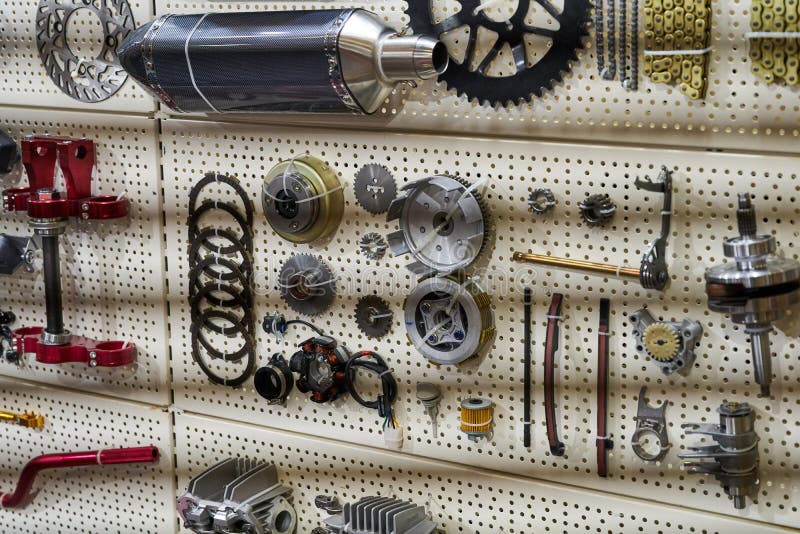Discover Top Quality Moto Parts NZ for All Your Motorcycle Requirements
Discover Top Quality Moto Parts NZ for All Your Motorcycle Requirements
Blog Article
Comprehending the Vital Parts of a Bike: A Comprehensive Overview for Lovers
For motorbike lovers looking to elevate their riding experience and ensure their bikes run smoothly, comprehending the necessary elements of a motorcycle is vital. Each aspect, from the engine's elaborate workings to the essential role of the stopping systems, not only affects efficiency yet additionally security and convenience.
Engine Parts

The camshaft plays a crucial role in controlling the timing of the engine's shutoffs, guaranteeing the precise opening and closing essential for effective gas and air consumption, as well as exhaust expulsion. This timing is critical to maintaining optimum engine efficiency and efficiency. In addition, the carburetor or gas injection system, relying on the motorcycle design, is in charge of blending air with gas in the right proportion for burning.
The air conditioning system, either air or liquid-based, functions to maintain the engine's temperature within functional restrictions, stopping overheating and ensuring longevity - moto parts nz. Each component, diligently created and integrated, adds to the seamless operation of the engine, specifying the motorcycle's power result and overall efficiency
Transmission System
Integral to the bike's performance, the transmission system guarantees efficient power transfer from the engine to the wheels. This system comprises a number of critical parts, including the clutch, gearbox, and final drive, each playing a vital role in equating the engine's power right into movement. The clutch, commonly operated by a hand lever, serves to engage and disengage the engine from the transmission, enabling smooth equipment changes and controlled velocity.
The gearbox, often described as the transmission appropriate, has a set of equipments that cyclists can manually move with to change the bike's rate and torque output. These equipments are arranged in a sequence that enables the motorbike to accelerate smoothly and maintain ideal engine performance across different rates. The majority of motorbikes make use of a sequential gearbox, needing the motorcyclist to move equipments in a fixed order.
Braking Systems
While comprehending the transmission system is key to harnessing a bike's power, just as crucial is the capacity to control and stop that power successfully, which is where stopping devices come into play. Brakes are vital for security and performance, offering the motorcyclist with the required control to browse different surfaces and problems. Generally, motorbikes include 2 kinds of braking systems: disc brakes and drum brakes.
Disc brakes are extra widespread in modern motorbikes as a result of their exceptional performance. They are composed of a brake disc, caliper, and pads. When turned on, the caliper squeezes the brake pads against the rotating disc, transforming kinetic energy right into warmth, consequently slowing down the wheel. This system offers far better warm dissipation, regular performance, and boosted quiting power, especially in wet conditions.
Conversely, drum brakes, though much less usual, are still found in some motorbikes. They work by pressing brake shoes versus the inner surface of a like it drum affixed to the wheel. While generally less reliable in warm dissipation and quiting power, drum brakes are easier and more cost-efficient.
Comprehending these braking systems' nuances enables cyclists to preserve their bikes appropriately and value the engineering that guarantees safe and efficient stopping.
Suspension and Steering
Suspension and steering systems are important elements that dramatically affect a motorbike's handling and trip convenience. The suspension system, being composed of forks at the front and shock absorbers at the rear, absorbs road abnormalities, improving stability and control. Front forks, inverted or commonly telescopic, compress and rebound to reduce effects, while rear shock absorbers preserve tire call with the roadway, vital for grip and safety.
Steering, focused around the handlebars, attaches the biker to the bike's directional control. The guiding head bearings ensure smooth operation, permitting precise ability to move. Appropriate positioning and maintenance of these bearings are important for foreseeable guiding action and decreasing rider tiredness.
The suspension's adjustability is an additional essential facet; preload, damping, and rebound settings permit customization published here to match different riding styles and problems. This adaptability is crucial for maximizing performance, whether navigating urban roads or taking on tough tracks. Innovations like electronic shock absorber provide real-time adjustments, improving adventure quality across varied terrains.

Electric Equipments
After ensuring a controlled and smooth ride through effective suspension and guiding systems, attention transforms to the electric systems, a crucial aspect of modern bikes. These systems play a vital duty not just in beginning the engine however likewise in powering numerous parts that boost the functionality and security of the bike.
At the heart of a bike's electric system is the battery, which shops electric energy required for starting the engine and powering auxiliary systems - motorcycle shop. The alternator or generator, coupled with the rectifier-regulator, guarantees the battery stays charged while the bike functions, transforming mechanical energy right into electric energy and maintaining voltage levels
The ignition system, another important element, is in charge of igniting the air-fuel mixture in the engine's cylinders. Modern bikes usually make use of an electronic ignition system, supplying better effectiveness and dependability compared to traditional systems.
Lights systems, consisting of headlights, tail lights, and signs, are additionally crucial, making certain exposure and safety for Continue the motorcyclist. Extra electronic parts such as sensors, control units, and shows add to innovative functions like gas injection management, anti-lock stopping systems (ABS), and electronic dashboards, even more boosting the riding experience.
Verdict
An extensive comprehension of a bike's necessary elements, including the engine, transmission system, braking devices, suspension, steering, and electrical systems, is important for fanatics intending to enhance convenience, performance, and safety and security. Proficiency of these components enables informed decisions regarding maintenance and upgrades, eventually enhancing the riding experience. By integrating this understanding, motorcyclists can guarantee their motorcycles run at peak efficiency and reliability, thereby optimizing both enjoyment and durability of their automobiles.
For bike fanatics looking to boost their riding experience and ensure their bikes run smoothly, recognizing the important components of a motorbike is extremely important.Indispensable to the bike's functionality, the transmission system ensures effective power transfer from the engine to the wheels.While understanding the transmission system is key to taking advantage of a motorbike's power, similarly crucial is the capability to manage and stop that power efficiently, which is where braking systems come into play. Usually, motorbikes feature 2 types of stopping systems: disc brakes and drum brakes.
A detailed understanding of a motorbike's vital elements, including the engine, transmission system, braking devices, suspension, guiding, and electric systems, is crucial for fanatics aiming to maximize comfort, efficiency, and security.
Report this page